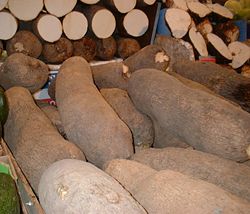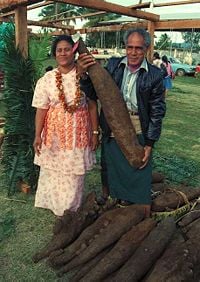Difference between revisions of "Yam" - New World Encyclopedia
| Line 83: | Line 83: | ||
*Consultative Group on International Agricultural Research (CGIAR), 2006, "Yam"[http://www.cgiar.org/impact/research/yam.html] | *Consultative Group on International Agricultural Research (CGIAR), 2006, "Yam"[http://www.cgiar.org/impact/research/yam.html] | ||
| + | *O'Hair, S.K., 1990, "Tropical Root and Tuber Crops", p. 424-428. In: J. Janick and J.E. Simon (eds.), Advances in new crops. Timber Press, Portland : OR.[http://www.hort.purdue.edu/newcrop/proceedings1990/V1-424.html#Yams] | ||
*University of Connecticut(UC), 2006, "Dioscoreaceae"[http://florawww.eeb.uconn.edu/acc_num/200000004.html] | *University of Connecticut(UC), 2006, "Dioscoreaceae"[http://florawww.eeb.uconn.edu/acc_num/200000004.html] | ||
| + | *White, L.D., 2003, ''Canoe Plants of Ancient Hawai'i'', "Uhi"[http://www.canoeplants.com/uhi.html] | ||
Revision as of 18:17, 14 August 2006
| Dioscorea (Yam) | ||||||||||||
|---|---|---|---|---|---|---|---|---|---|---|---|---|
 | ||||||||||||
| Scientific classification | ||||||||||||
|
Yam is the common name for members of the genus Dioscorea (family Dioscoreaceae). There are more than 150 different varieties of yam. Some species are cultivated for the consumption of their starchy tubers in Africa, Asia, Latin America and Oceania.
The word yam comes from Portuguese inhame or Spanish ñame, which both ultimately derive from the Wolof word nyami, meaning "to eat". They are used in a similar fashion to potatoes, and are sometimes called a potato substitute, though in areas where yams are grown, potatoes are the newer vegetable.
Yam tubers can grow up to seven feet (approx. two meters) in length and weigh up to 150 pounds (68 kg). The yam has a rough skin which is difficult to peel, but which softens after heating. Yam skins vary in color from dark brown to light pink. The majority of the yam is composed of a much softer substance known as the "meat". This substance ranges in color from white to bright orange in ripe yams.
Yams are a primary agricultural commodity in West Africa and New Guinea. They were first cultivated in Africa and Asia about 8000 B.C.E., probably because they were able to flourish in environments where growing leafy vegetables and keeping livestock was difficult. To this day, the yam tuber remains crucial to survival in the region; it can be stored for four to six months without refrigeration, which makes it a valuable resource for the yearly period of food scarcity at the beginning of the wet season.
Yams are used as food plants by the larvae of some Lepidoptera species including Palpifer sordida.
Preparation
Yams of African species must be cooked to be safely eaten because various natural substances in raw yams can cause illness if consumed. Preparing some species of yam is a time-consuming process, involving days of pounding, leaching, and boiling to remove the toxins. Yams may be served fried, boiled or pounded into a paste. In the Philippines, the purple ube variety of yam (Dioscorea alata, also known in India as ratalu or violet yam) is eaten as a sweetened dessert called halaya, and is also an ingredient in another Filipino dessert, halo halo.
An exception to the cooking rule is the Japanese mountain yam (Dioscorea opposita), known as nagaimo or yamaimo depending on the root shape. It is eaten raw and grated, after only a relatively minimal preparation: the whole tubers are briefly soaked in a vinegar-water solution, to neutralize irritant oxalate crystals found in their skin. The raw vegetable is starchy and bland, mucilaginous when grated, and may be eaten plain as a side dish, or added to noodles.
Yams and sweet potatoes
In the United States, sweet potatoes (Ipomoea batatas) are often referred to as "yams". Sweet potatoes labeled (incorrectly, according to some) as "yams" are widely available in U.S. grocery stores. True yams are only found in specialty markets such as those that serve Asian or Caribbean communities.
| Top Yam Producers - 2005 (million metric ton) | |
|---|---|
| Nigeria | 26.6 |
| Ghana | 3.9 |
| Côte d'Ivoire | 3.0 |
| Benin | 2.3 |
| Togo | 0.6 |
| Columbia | 0.3 |
| World Total | 39.9 |
| Source: UN Food & Agriculture Organisation (FAO)[1] | |
In contrast, people in New Zealand use the word "yam" to refer to the oca (Oxalis tuberosa), and the word "kumara" to refer to the sweet potato.
Yam culture
The coming of the yams (one of the numerous versions from Maré in Pene Nengone (Loyalty Islands - New Caledonia) [2]
In many societies yams are so important that one can speak of a yam culture. Growing the tuber is associated with magic; the best ones must be given to the chief or king; there is a series of myths connected to a divine origin; a farmer may gain a lot of prestige by growing the largest or longest yam; etc.
- Micronesia, for example Pohnpei.
- Melanesia, for example Vanuatu, Papua New Guinea.
- Polynesia, west Polynesia only, like Samoa, Tonga. In Tonga the ancient names of the months of the year and the names of the days of the moon-month were all geared towards the yam culture.
Selected species
- Dioscorea alata - ube, purple yam, water yam
- Dioscorea altissima - dunguey
- Dioscorea bulbifera - air yam, air potato
- Dioscorea cayenensis - yellow Guinea yam
- Dioscorea dumetorum - bitter yam
- Dioscorea elephantipes - Hottentot yam
- Dioscorea esculenta - lesser yam, potato yam
- Dioscorea floridana - Florida yam
- Dioscorea hispida - intoxicating yam
- Dioscorea opposita (syn. Dioscorea batatas, Dioscorea japonica, Dioscorea polystachya, Dioscorea oppositifolia) - Chinese yam, Japanese mountain yam, Korean yam, yamaimo
- Dioscorea polygonoides - mata gallina
- Dioscorea preussii - Preuss' dioscorea
- Dioscorea rotundata - Guinea yam
- Dioscorea sansibarensis - Zanzibar yam
- Dioscorea trifida - Indian yam
ReferencesISBN links support NWE through referral fees
- Consultative Group on International Agricultural Research (CGIAR), 2006, "Yam"[3]
- O'Hair, S.K., 1990, "Tropical Root and Tuber Crops", p. 424-428. In: J. Janick and J.E. Simon (eds.), Advances in new crops. Timber Press, Portland : OR.[4]
- University of Connecticut(UC), 2006, "Dioscoreaceae"[5]
- White, L.D., 2003, Canoe Plants of Ancient Hawai'i, "Uhi"[6]
Credits
New World Encyclopedia writers and editors rewrote and completed the Wikipedia article in accordance with New World Encyclopedia standards. This article abides by terms of the Creative Commons CC-by-sa 3.0 License (CC-by-sa), which may be used and disseminated with proper attribution. Credit is due under the terms of this license that can reference both the New World Encyclopedia contributors and the selfless volunteer contributors of the Wikimedia Foundation. To cite this article click here for a list of acceptable citing formats.The history of earlier contributions by wikipedians is accessible to researchers here:
The history of this article since it was imported to New World Encyclopedia:
Note: Some restrictions may apply to use of individual images which are separately licensed.
